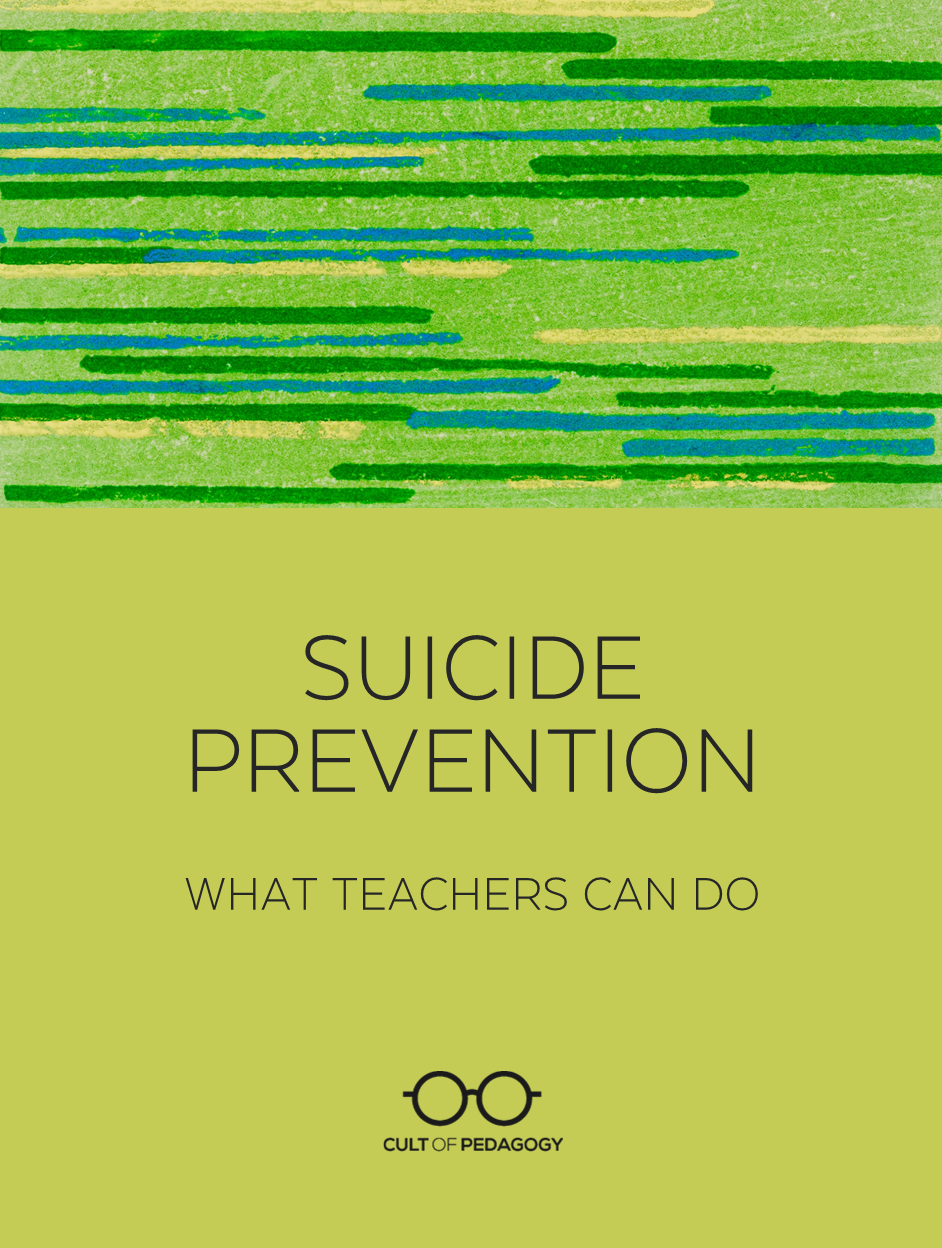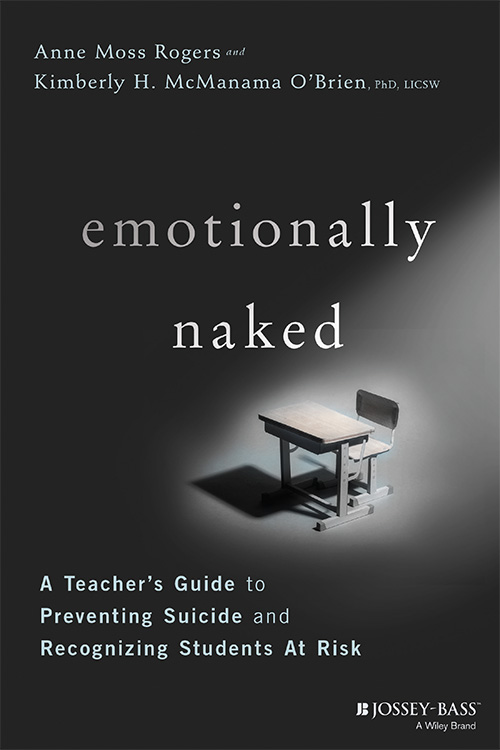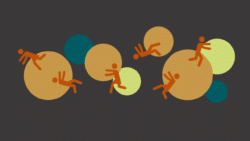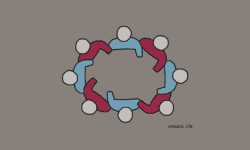
Listen to the interview with Anne Moss Rogers (transcript):
Sponsored by Listenwise and ISTE
This post contains Amazon Affiliate links. When you make a purchase through these links,
Cult of Pedagogy gets a small percentage of the sale at no extra cost to you.
After Anne Moss Rogers lost her 20-year-old son to suicide, it took her a long time to understand why it happened. “My son suffered from depression and addiction,” she said in her 2018 Ted Talk, “but that doesn’t mean we were prepared. Suicide was not on my radar because no one was talking about it. And someone needed to.”
Since her son’s death, Rogers has devoted her time to learning everything she can about suicide and helping others understand what they can do to prevent it. Most recently, she has focused her work on teachers, whom she sees as a vital link between troubled students and the professionals who can help them cope with suicidal thoughts. In her new book, Emotionally Naked: A Teacher’s Guide to Preventing Suicide and Recognizing Students at Risk, she and co-author Kimberly O’Brien give teachers the information and tools they need to help reduce suicide in young people.
“(Teachers) see millions of adolescents nationwide,” Rogers explained in our podcast interview. “Their eyes, ears, gut feelings and all of that are a critical part of the workflow of demoting suicide as a cause of death in young people. Their relationships with students are a vital asset to that process. Think of teachers as a bridge from students who are struggling to the resources like the school counseling team, their parents and mental health resources.”

What follows is a summary of the key takeaways from our conversation: common misconceptions, contributing factors, signs and risk factors to look out for, and other things teachers can do to prevent youth suicide.
A note about language: Rogers makes a point to avoid the phrase “committed suicide” when talking about this issue. “It used to be a crime in 1400’s England,” she explains, “and it’s been part of our lexicon for hundreds of years. We know now that it’s a public health crisis, so (instead) we’d say died by suicide or she suicided. We want to avoid commit because it’s not a crime. It already has a lot of stigma and shame, and we can start to take away or erode that stigma and shame by using the right language.”
Common Misconceptions about Youth Suicide
Emotionally Naked reviews a long list of misconceptions about youth suicide; two of them are crucial for teachers to be aware of:
Misconception 1: Talking about suicide puts the idea in students’ heads.
According to the National Institute of Mental Health, “Studies have shown that asking people about suicidal thoughts and behaviors does not cause or increase such thoughts. Asking someone directly, ‘Are you thinking of killing yourself?’ can be the best way to identify someone at risk for suicide.”
Misconception 2. Students contemplating suicide don’t want anyone to know.
“What I have found in my research is kids do want to tell,” Rogers says. “They’re not going to want to go to a therapist, and they’re going to want to talk to someone with whom they have a relationship. So few people tell a mental health professional. They tell us, so we need to know what to do, what to say and how to receive that information with empathy and kindness and know what to do in that next step.”
Factors that Contribute to Youth Suicide
Rogers says that students who die by suicide often start off in a vulnerable state. “By vulnerable,” she explains, “we mean one that’s exposed to violence or other trauma, lives with a mental illness such as bipolar or depression, has lost a family member and is grieving, or any of the ACEs—Adverse Childhood Experiences. So it is the constellation of those issues all together.”
What often happens next is a significant life change that can be the “last straw,” pushing the child toward suicidal thoughts. These changes—which should prompt teachers to pay closer attention—often fall into two categories:
Transitions
Any major transition, such as moving from middle to high school, high school to college, or college to “real life” can be a trigger. Moving to a new school, new state, or new country can also put these students at risk.
“Also, those mini-transitions from school to Christmas break, from Christmas break back to school,” Rogers adds. “We find that a lot of kids die by suicide over the break for the summer. So those mini-transitions are key times as well.”
Relationship Disruptions
When the status of a relationship changes, this can also activate thoughts of suicide. “That’s romantic breakups, fights with siblings, parents, a best friend, a boyfriend, a parent divorce, being bullied, grief over a loss of a loved one,” Rogers explains.
COVID presents us with both of these: transitions into and out of at-home learning, for one, and the loss of loved ones due to the disease. On top of that, family job changes and other economic factors have placed extra stress on families. At this time in history, we have even more reasons to pay close attention to our students’ social and emotional well-being.
Suicide Signs and Risk Factors to Watch For
Some behaviors teachers can look out for include the following:
- frequent falling asleep in class
- sudden, significant drop in grades
- frequent visits to the school nurse or clinic for accidents, headaches, backaches, or sore muscles
- self-isolation
- reckless behavior: an escalation in drinking, drug use, or self-harming behavior
- increased perfectionism or sensitivity to making mistakes
- cries for help: expressions like “I just want to die,” “I just can’t do this anymore,” or “I’m such a burden” in speech, writing, or artwork
Although some of these may just be temporary or simply a passing mood or phase, teachers are encouraged to take them seriously. “It’s not always what (students) say but how it makes you feel; you feel this sense of despair when they say something,” Rogers says. “And I want teachers, to act on that. You’re going to feel like, Oh my gosh, I’m not qualified, and it’s very uncomfortable. I want teachers to override that discomfort.”
How to Intervene: A Four-Step Process
Rogers strongly recommends that teachers get formal training in suicide prevention (a good place to start is LivingWorks Start, which takes just 90 minutes online). Until then, she suggests this four-step process for responding to a student who you suspect is having suicidal thoughts:
- Engage the student in private conversation. Do this at the first sign that something is seriously wrong.
- Listen with empathy, without trying to ‘fix’ the problem. “So you don’t want to say, You have so much to live for,” Rogers says. “You want to say, Tell me more. How long has this been going on?“
- Ask, “Are you thinking of suicide?” This is likely to be the most uncomfortable part of the conversations, but Rogers insists that it’s vital to ask this question directly.
- Connect the student with help. Rogers recommends going with the student to initiate a conversation with a school counselor. This transparency shows partnership between colleagues, alleviates fear of the unknown in the student, and gives the student agency in the process.
If you’re a new teacher and the first few steps seem like too much, Rogers advises that you simply go right to step 4 and connect the student with another adult, like a school counselor, who can help. But don’t wait—express your concern as soon as it arises.
How Educators Can Work Toward Prevention
Along with learning to recognize risk factors and warning signs, teachers can also incorporate practices that have a positive impact more “upstream,” before significant problems develop into crises.
- Embed Mental Health Education into the Curriculum
“It’s having those conversations and normalizing them within the school culture,” Rogers says. Embedding social-emotional education into daily classroom teaching, the way Wendy Turner recommended in a past post, teaches students that difficult emotions are a normal part of life, and it’s healthy to talk about them and ask for help when you need it. - Nurture Student Relationships
“We know that kids that die by suicide often feel like they’re not connected or they don’t belong,” Rogers says. “So any kind of way you can get students to collaborate more and get to know each other better and create that sense of belonging and connectedness in your classroom, family, community, I think that is one of the biggest things you can interject in your classroom.” - Teach Coping Skills
“Anytime you can integrate lessons that help kids with critical thinking and developing coping strategies and life skills,” Rogers says, “those are what are going to help them through those difficult times and those adverse circumstances. Once they practice them, they will remember them when they need to later on.” - Systematize Faculty Collaboration
Teachers and other professionals need to set up a protocol for how to communicate when a troubled student has been identified. “Teachers need to know, I’ve identified this student. What happens next? Who do I go to? What does that process look like?” Thinking through these processes ahead of time ensures that students don’t slip through the cracks. - Make Crisis Resources Visible
Printing and posting ads for Crisis Text Line gives students tools they can use to reach out for help.
Although the problem of youth suicide may seem overwhelming, Rogers’ message is ultimately one of hope. Teachers are just as likely, if not more likely, to notice small changes or cries for help than other adults, simply because of the amount of time spent with students. It’s crucial that we follow our instincts when we suspect something is wrong, because taking action can save lives.
“Intervention works,” Rogers says. “Listening works. And resilience and recovery are not only possible, they’re probable.”
If you have thoughts of suicide, please reach out to the Prevention Lifeline at 1-800-273-8255 or the Crisis Text Line by texting HOME to 741741.
Join our mailing list and get weekly tips, tools, and inspiration that will make your teaching more effective and fun. You’ll get access to our members-only library of free downloads, including 20 Ways to Cut Your Grading Time in Half, the e-booklet that has helped thousands of teachers save time on grading. Over 50,000 teachers have already joined—come on in.






I looking forward to receiving additional information.
Thank you for commenting, David.
I too lost my 23 year old son to suicide 3 years ago. I too am a teacher.
I appreciate you sharing this message with teachers but just like your guest cautioned on using the term committed, I want to encourage you to remind teachers that there may be no signs or they may not see them and to NOT blame themselves for not doing more. Suicide is an insidious disease and guilt is often so damaging for those left behind.
I just wanted you to know.
I love your work.
Kelly. First of all I am so sorry you lost your son the same way i did. Three years it’s still pretty raw but for me that’s when a lot of healing happened.
While 85% of those who die by suicide do let their intentions be known in some way, that leaves 15% that leave no clue. And of that 85% the clues can be very subtle and hard to distinguish from normal teen angst. Which is why a lot of our book focuses on building resilience, critical thinking skills, both active and less active mindfulness skills, connections and coping strategies. We want to prevent them from getting to crisis because it’s always easier to pull a kid out of choppy Waters than class five rapids. And teachers who had been through loss talk about what helped them and how difficult it was to process the loss and stand in front of a class of grieving students.
And of course the empty desk syndrome and what to do about it is a theme.
Thank you for your comment. I hope you will share with your colleagues.
Thank you for the suicide pod cast. I am grateful for the bravery you show in advocating for a deeper understanding of such an important topic. It is so true that the transitions are gigantic triggers for students.
Thank you for listening, Tobi. Any time a teacher takes what little time they have to listen to a podcast it is appreciated.
I recently learned about your podcast from one of my graduate students. The episode they specifically referenced was on Street Data. It was amazing and I want to eventually find the right place for this in my course I teach each fall. As I continued listening to other episodes, I continued to learn. It was the Suicide Prevention: What Teachers Can Do episode that has prompted me to write.
I am a counselor educator at Grand Valley State University in Grand Rapids, MI. I have also served as the president of the Michigan School Counselor Association. I do all I can to advocate for our profession, including advocating for the use of correct terminology surrounding the title for school counselors.
In the above referenced podcast, the guest, Ann Moss Rogers, accurately referred to school counselors by that title. This has been the accepted title since the 1990’s and more accurately reflects the transformed role of school counselors. In reply, Ms Gonzalez used the title “guidance counselor”. This is an antiquated term, however, which is unfortunately still perpetuated today. This title refers to the days when school counseling was a job in a school as opposed to a comprehensive, developmental, and preventative program. In fact, research conducted by Zyromski, et.al, (2019) provides evidence as to how titles relate to the perceived competency of school counselors vs. those who use the title guidance counselor to describe their work. This research is available at https://www.schoolcounselor.org/getmedia/3b7fe053-5cbe-4b55-a9dd-4d59b239abf4/Title-Matters-Research-Report.pdf.
I respectfully invite Ms Gonzales to learn more about the transformed role of school counselors to share with the listeners of this valuable podcast. The American School Counselor Association (ASCA) has tremendous resources available as well as board members, association staff, and American School Counselor Association School Counselor of the Year awardees who might be fabulous guests. The ASCA website is https://www.schoolcounselor.org/.
School counselors possess a professional identity as educator counselor. School counseling programs are integral to improving student outcomes in achievement, attendance, and discipline. I believe your listeners would benefit greatly by learning more about how these professionals can support all educators in better serving their students.
Respectfully,
Judy Stearns Williams
Judy- One, thanks for listening. And two, school counselors and their protocols were essential interviewees for the book Kim and I wrote. Two of them in particular, went above and beyond. People are still using “guidance” is associated with counselors about as often as “committed” is still used with the word suicide. Today’s school counselor, school social worker or school psychologist is absolutely an integral part of a school environment. Thank you for pointing out the change in language and the links to their role in schools today.